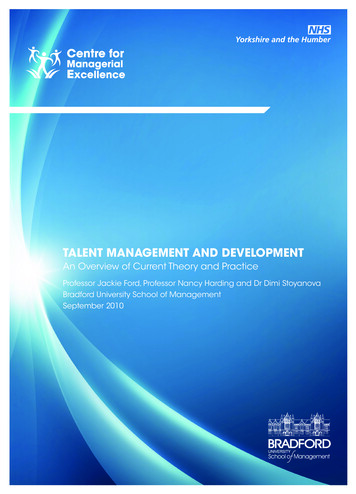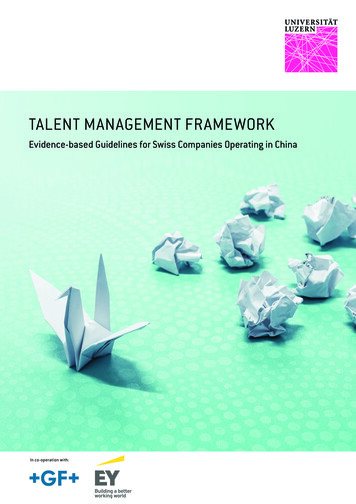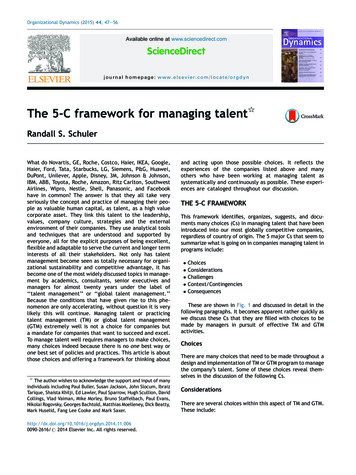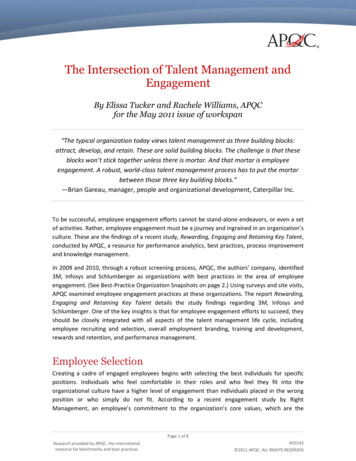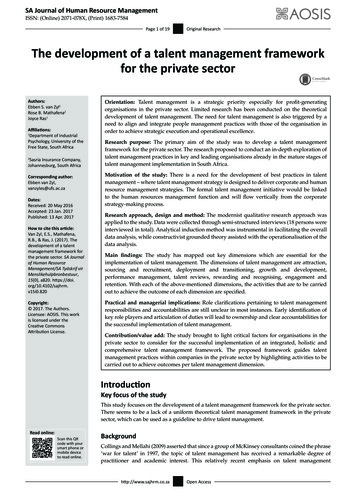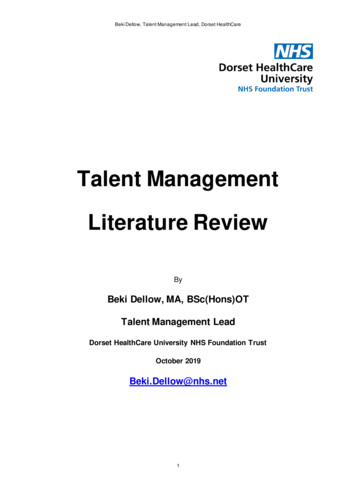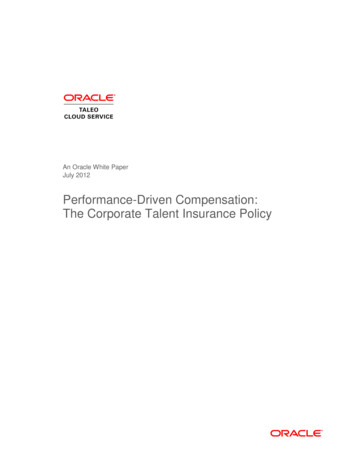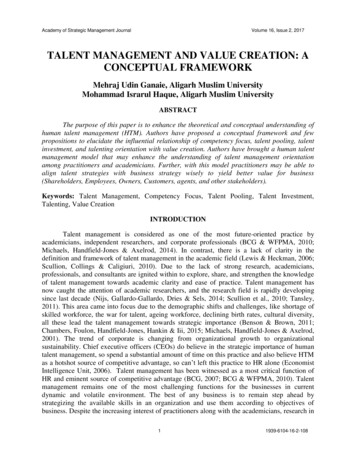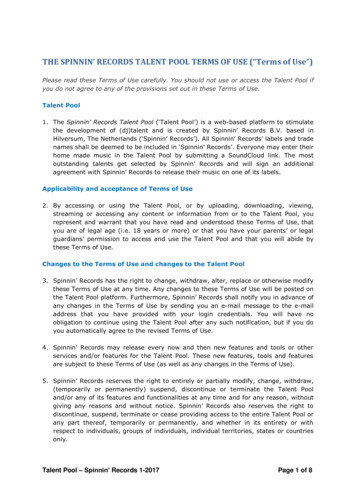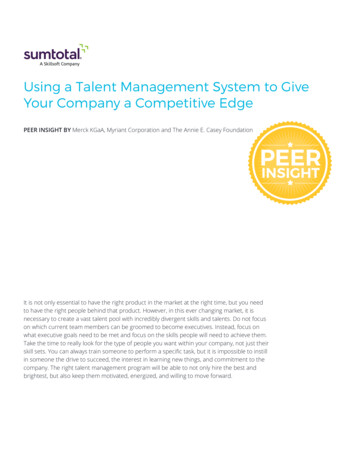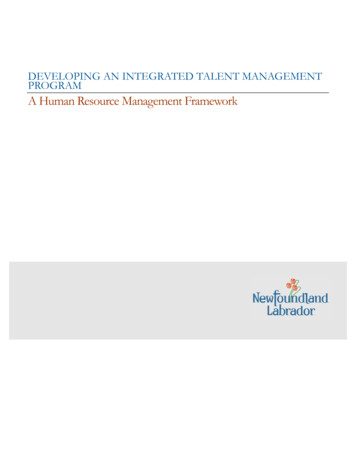
Transcription
DEVELOPING AN INTEGRATED TALENT MANAGEMENTPROGRAMA Human Resource Management Framework
HR POLICY AND PLANNING DIVISIONHUMAN RESOURCE BRANCHPublic Service SecretariatApril, 2008Government of Newfoundland and LabradorP.O. Box 8700St. John’sNewfoundland and LabradorA1B 4J6
TABLE OF CONTENTSINTRODUCTION . 1MANAGING TALENT . 3BEING A PREFERRED EMPLOYER. 4BENEFITS OF A TALENT MANAGEMENT PROGRAM . 5FOUNDATION FOR AN INTEGRATED TALENT MANAGEMENT PROGRAM. 6GATHERING AND ANALYZING THE EVIDENCE. 6DEVELOPING TALENT POOLS . 7ATTRACTING EXTERNAL TALENT . 7BUILDING AN EXTERNAL TALENT POOL . 8INVESTMENT IN THE ORGANIZATION’S INTERNAL TALENT . 9ORGANIZATIONAL CULTURE . 10PREPARING TO DEVELOP AN INTEGRATED TALENT MANAGEMENT PROGRAM. 12CRITICAL SUCCESS FACTORS . 13SUMMARY OF THE PROGRAM DEVELOPMENT PROCESS . 14
DEVELOPING AN INTEGRATED TALENT MANAGEMENT onDeveloping an Integrated Talent Management Program will assist Departments in achievingsuccessful organizational outcomes.Talent management is about more than just attracting and retaining talent. It is also aboutresearching, developing, and implementing a series of human resource (HR) initiativesand looking at how these initiatives fit together to manage the talent available to aDepartment.Building and enhancing employee potential will not only benefit employees, it will also supportthe organization in meeting its goals and objectives while focusing on the provision of excellencein public service.The development of an Integrated Talent Management Program (ITMP) can be used bydepartments as a key strategy for addressing a number of critical HR issues in theNewfoundland and Labrador Public Service. Managing an organization’s HR and the talentthat is available to the organization is both a corporate and a departmental priority.C R I T I C A LH RI S S U E SCurrent competency requirementsSkills gapsCompetitive labour marketFast-pace changes in work and workenvironmentChanging needs and interests ofcurrent and potential employeesThis guide provides departments with some general tools and processes that can be used indeveloping a department-wide ITMP or one that is specific to a particular occupationalgroup.1
DEVELOPING AN INTEGRATED TALENT MANAGEMENT PROGRAMAHUMANRESOURCEMANAGEMENTFRAMEWORKHuman Resource /Workforce Planning ProcessReview Business Goals andObjectivesDeveloping an IntegratedTalent Management ProgramConduct Environmental ScanBeing a “Preferred Employer”Conduct Gap Analysis ofWorkforceDeveloping Internal Talent PoolsBuilding External Talent PoolsOrganizational CultureSet HR Priorities and DevelopStrategiesImplement and EvaluateStrategiesOrganizational Readiness2
DEVELOPING AN INTEGRATED TALENT MANAGEMENT PROGRAMAHUMANRESOURCEMANAGEMENTFRAMEWORKManaging TalentManaging talent is about ensuring that the organization has an external talent pool availablefrom which to draw, qualified candidates, while at the same time continuing to build on theexisting talent that exists within the organization.ExternalAttraction andRecruitmentEffortsStrategies forBuilding andEnhancingInternal Talent3
DEVELOPING AN INTEGRATED TALENT MANAGEMENT PROGRAMAHUMANRESOURCEMANAGEMENTFRAMEWORKBeing a Preferred EmployerBeing a preferred employer is integral to competing for talent. It is necessary for bothattracting new hires to the organization and retaining the talent that the organizationcurrently employs. Being an employer that people want to work for is about more than justhitting or exceeding market medium with respect to wages. There are many factors thatinfluence the attraction and retention of workers, in addition to compensation.While compensation is important to competitiveness, it is often not the single mostimportant factor to employees or potential employees. People want to work for anorganization that they are proud to be working for. Other factors that influence a person’sdecision to accept or remain with an employer are noted in the following text box.I N F L U E N C I N GF A C T O R SSupport for professional developmentOpportunities for career advancementHaving respected and trusted leadersAbility to direct individual workAbility to influence organizational initiativesand directionsFlexible work environmentsWorkplace innovationCommunicationRecognition and respectIn managing talent, an organization must build an attractive employer brand so that theperception of the organization to both potential and existing employees is one of a progressiveemployer that is focused on achieving organizational priorities and excellence in public service,and recognizes the value of employees to organizational efforts.4
DEVELOPING AN INTEGRATED TALENT MANAGEMENT PROGRAMAHUMANRESOURCEMANAGEMENTFRAMEWORKBenefits of a Talent Management ProgramOrganizations that effectively manage their talent provide benefits to the employee and to the clientswhom the organization serves.The outcomes associated with effective talent management are depicted in the figure below.IncreasesemployeeproductivityAligns employeework GEMENTAssists theorganization indevelopingtalent poolsRicher careerdevelopmentand Focuses on theprovision ofexcellence inpublic service5
DEVELOPING AN INTEGRATED TALENT MANAGEMENT PROGRAMAHUMANRESOURCEMANAGEMENTFRAMEWORKFoundation for an Integrated Talent ManagementProgramFor an ITMP to work effectively it must be informed by evidence. This evidence needs to beanalyzed and strategies then formulated based on the findings. It is important to recognizethat no one strategy may be the best, rather a set of strategies (HR bundling) may need tooccur to effectively address HR issues.Gathering and Analyzing the EvidenceData that is required to determine what strategies may be effective in the management of anorganization’s talent can be achieved through a number of methods, including, but notlimited to: Organizational directions, priorities, goals and objectives Exit surveys/interviews Entry interviews Regular employee surveys Surveys and qualitative information from students and other potential employees Divisional and departmental meetings Employee demographics Demographics of the external labour market Documented attraction and retention difficulties Internal departmental scan of culture, leadership, management practices, workenvironment, decision-making and other business processes and practices Documentation gained from recruitment processes6
DEVELOPING AN INTEGRATED TALENT MANAGEMENT PROGRAMAHUMANRESOURCEMANAGEMENTFRAMEWORKDeveloping Talent PoolsThe organization must continuously be engaged in developing and building talent pools,especially for those professional and technical skills for which there exists a high labourmarket demand, or where specialized knowledge and skills are required.Developing a talent pool is essentially building sources of talent available to theorganization that can be drawn upon when the need arises. The talent base can be eitherinternal or external, or both, and is developed in an effort to ensure business continuity.Strategies will differ depending on the type of skill set required, when it is required, andhow critical it is in meeting organizational priorities. Strategies to address immediate needsmay differ from those that can be established to address future needs. Moreover,organizational priorities continuously shift, so a skill set critical to operations may alsochange.S T E P ST OC O N S I D E RReview position descriptionDevelop competency profiles for critical positionsAssess current competencies available to the DepartmentDetermine whether competencies can be found internallyDevelop strategies to address current or immediate needsPlan for future needs nowAttracting External TalentStrategies employed in attracting experienced new hires may include building an employerbrand that is conducive to attracting top talent. This may mean developing strategies toshowcase public service work, especially for those positions that are critical to the currentrequirements of the organization. In building the employer brand, the organization mustalso ensure that the work environment and organizational culture supports a positiveemployee-employer relationship and meets or exceeds employee expectations.Moreover, developing strategies focused on diversity or immigration, continuing toparticipate in career fairs and expos that market the organization and public service work,and developing specialized recruitment programs specific to critical occupational groupscan also assist the organization in its efforts to attract new and experienced talent to theorganization. Success in implementing these strategies will involve the collaboration andcooperation of central agencies and departments.7
DEVELOPING AN INTEGRATED TALENT MANAGEMENT PROGRAMAHUMANRESOURCEMANAGEMENTFRAMEWORKBuilding an External Talent PoolKey to building a talent pool from which to draw upon is to support the development of a longterm attachment to the organization. In order to do this, the organization must have effectiveand supportive leadership that will lay the foundation on which this will occur.Engaging students in the early stages of their studies is important to building an externalpool. Encouraging students to pursue a career in the public service will also assist theorganization in building a potential talent base and offer the organization an opportunity tonot only begin the development of a long term attachment of the student to theorganization, but also develop specific skill sets needed in the public service.Strategies to engage students include: Student employmentLook for opportunities to create entry-level Part-time employmentpositions Summer employmentHire students on a temporary basis to assess Organizational support forpotentialCo-operative programsConsider working with a post-secondaryInternshipsinstitute to develop specific skill requirementsFellowshipsif they are not readily available in the labourBursariesApprenticeshipsmarketSeat Purchase ProgramsEngage current staff to speak with potentialExchange Programsemployees – develop an Employee“Career Pathing” – e.g. bring aAmbassador ProgramCo-op student back for 2nd, 3rdActively participate in job fairs and careerand 4th work terms, until pointexposof hire.O P P O R T U N I T I E SParticipate in student internships and begintraining of specialized skills needed within thepublic serviceNote: Keep your fingers on the pulse When students are employed with the Department, ask them whatthey are looking for in an employer. This provides insight into what is important to students in terms ofbeing a preferred employer.8
DEVELOPING AN INTEGRATED TALENT MANAGEMENT PROGRAMAHUMANRESOURCEMANAGEMENTFRAMEWORKInvestment in the Organization’s Internal TalentBuilding on the organization’s existing talent will support the organization’s efforts to planand address critical skill requirements. Furthermore, investing in the organization’s currenthuman resources will benefit the employee, which will increase the likelihood of retention andenhance individual and organizational performance.With respect to managing internal talent there are three major elements:1. Professional Development2. High Potential Development3. Performance ManagementStrategies for enhancing the organization’s internal talentProfessionalDevelopmentAccess to assessmentcentres and toolsTargeted learning andtrainingEducational supportprogramsMentoringHigh Potential DevelopmentPerformance ManagementCareer assignment programs(stretch and short-term specialassignments)Performance enhancement –establish individual goals andprioritiesCross-functional opportunities(involvement in crossdepartmental work teams)Competency assessmentNational and internationalcommittee involvementIndividual learning planPerformance feedbackRewards and recognitionCoachingSupport to present work atnational and international eventsWork load analysis (resourcemanagement, decrease non-valueadded work)Participation in professionalorganizationsSupports to work within full scopeof practiceInvolvement with internalworking groups, committees, andcommunities of practice9
DEVELOPING AN INTEGRATED TALENT MANAGEMENT onal CultureAn important component of managing an organization’s talent is developing strategies toimprove elements of the organizational culture and the work environment.Retention and employee satisfaction, and thus, organizational performance is enhanced by anumber of factors involving the employment relationship, work environment and quality ofwork life.WorkEnvironmentHealth and safetyEffective ManagementPhysical and social workenvironmentBusiness processesAdequate ResourcesLearning & DevelopmentQuality ofWork-LifeReasonable workdemandsSkilled co-workersWork-Life nizational PerformanceImproved productivity and retentionReduced absenteeism10High ationship
DEVELOPING AN INTEGRATED TALENT MANAGEMENT PROGRAMAHUMANRESOURCEMANAGEMENTFRAMEWORKSome questions to consider 1. What are the organization’s values?2. Does the organization’s business processes and culture support these values?3. Is the organization diverse? (i.e. Does it represent the population it serves?)4. Is the organization flexible? (i.e. How adaptable is the organization and its peopleto shifting organizational priorities?)5. Does the organization value creativity and innovation? If so, how?6. How effective is the organization’s leadership in setting a vision for thedepartment and articulating this vision to staff?7. What types of management practices and supervisory styles are evident? Giventheir content, which ones work and which ones do not?8. How effective are the organization’s internal communication methods? (i.e. Dosupervisors and managers hold regular staff meetings where organizationalpriorities are discussed and employee input is encouraged?)9. What are the business and decision-making processes of the organization?11
DEVELOPING AN INTEGRATED TALENT MANAGEMENT PROGRAMAHUMANRESOURCEMANAGEMENTFRAMEWORKPreparing to Develop an Integrated TalentManagement ProgramUnderstandingOrganizational ReadinessOther HR StrategiesMoving ForwardBefore starting todevelop an ITMP, itis critical thatdepartmentalmanagers /supervisors have agood understandingof what talentmanagement meansfor the department,and be committedto the process.How ready is the department tostart the development process?Do other strategies need tobe developed to supportan integrated talentmanagement program?(e.g. diversity strategy,immigration strategy,employer branding,marketing campaigns)Ensure HR workforceplanning is acontinuous process. Itis often the impetusfor developing anITMP. Workforceplanning is also vitalin the identification ofcritical needs andresource requirements,including present skillsgaps and forecastedrequirements.Does the department havesupporting HR programsavailable?(e.g. performancemanagement/performanceenhancement; individuallearning plans; workforceplanning)Are departmental employeesactively engaged in theseprograms?How accountable are managersand supervisors for employeedevelopment?What is the level ofcommitment by departmentalexecutives?Does a supportiveorganizational culture exist?(e.g. flexibility, effectiveleadership, effectivecommunication processes)Collect data fromother sources toensure that theprogram is informedby evidence. Ifunreliable/invalidinformation is used indeveloping a program,its effectiveness willbe limited or nonexistent.Develop a projectplan with deliverablesand engage incontinuous evaluationand programmodification.How open are departmentalmanagers to change?12
DEVELOPING AN INTEGRATED TALENT MANAGEMENT PROGRAMAHUMANRESOURCEMANAGEMENTFRAMEWORKCritical Success FactorsThere are numerous critical success factors in developing and implementing an ITMP. Havingaccess to good data, and the critical appraisal and analysis of that data, is essential in developingstrategies to address the needs of the organization. Effective and continuous workforce planning isalso essential. Moreover, it is the quality of the workplace that is integral to the attraction andretention of top talent. In addition to these factors, the following organizational elements must bepresent if an ITMP is to be effective: Active participation by senior executivesAlignment of the program with the strategic directions of the organizationAccountability for the program at the director and supervisory levelEffective departmental HR management and supportsEmployee input, engagement, and participationContinuous evaluation, monitoring, and improvement effortsEffective organizational communication of the program13
DEVELOPING AN INTEGRATED TALENT MANAGEMENT PROGRAMAHUMANRESOURCEMANAGEMENTFRAMEWORKSummary of the Program Development ProcessStrategic ProgramEvaluation andModificationWorkforcePlanningIdentify currentand forecastedskills gapPlanning and Managingfor ResultsImplementSpecificHR 14Detailed DataCollection andAnalysis
NOTES15
A HUMAN RESOURCE MANAGEMENT FRAMEWORK 3 Managing Talent Managing talent is about ensuring that the organization has an external talent pool available from which to draw, qualified candidates, while at the same time continuing to build on the existing talent that exists within the organization. Strategies for

